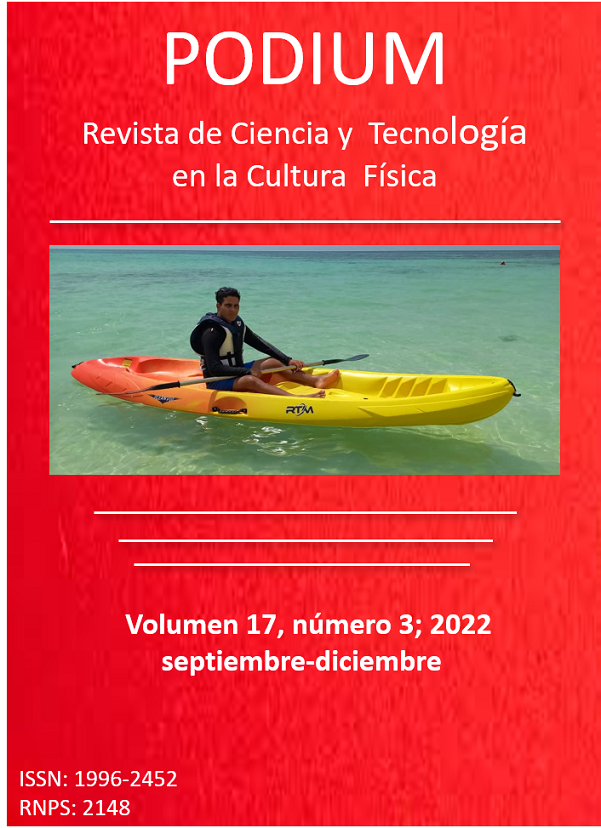Programa de exercícios para transferências e marcha em pacientes feridos da medula espinhal
##plugins.themes.bootstrap3.article.main##
Resumo
Objetivo: Descrever como o programa de exercícios físicos CIREN influencia a marcha e as transferências em pacientes com lesões da medula espinhal.
Materiais e métodos: De acordo com o desenho metodológico, o tipo de estudo é experimental, de acordo com o método de estudo é observacional de acordo com o tempo de ocorrência dos fatos e registro de informações. Para o desenvolvimento da pesquisa, foi selecionada uma amostra de 15 pacientes com níveis de lesão entre T1 e T6 que preenchiam os critérios de inclusão.
Resultados: Mudanças estatisticamente significativas na marcha e transferências foram observadas no grupo; por níveis de lesão, as lesões entre T1 e T6 não mostraram mudanças no gerenciamento de escadas e transferências do andar para a cadeira; por sexo, tanto homens quanto mulheres não mostraram mudanças estatisticamente significativas no gerenciamento de escadas e transferências do andar para a cadeira.
Conclusões: O programa de exercícios utilizado na reabilitação de pacientes é eficaz na produção de mudanças nas atividades de marcha e transferência. O tempo de reabilitação deve ser aumentado para lesões acima de T6.
Downloads
##plugins.themes.bootstrap3.article.details##
Referências
Abualait, T. S., & Ibrahim, A. I. (2020). Spinal direct current stimulation with locomotor training in chronic spinal cord injury. Saudi Medical Journal, 41(1), 88-93. doi:10.15537/smj.2020.1.24818, https://pubmed.ncbi.nlm.nih.gov/31915800/
Albuquerque, P. L., Campêlo, M., Mendonça, T., Fontes, L. A. M., Brito, R. d. M., & Monte-Silva, K. (2018). Effects of repetitive transcranial magnetic stimulation and trans-spinal direct current stimulation associated with treadmill exercise in spinal cord and cortical excitability of healthy subjects: A triple-blind, randomized and sham-controlled study. PloS one, 13(3), e0195-276. doi:10.1371/journal.pone.0195276 ,https://pubmed.ncbi.nlm.nih.gov/29596524/
Bye, E. A., Harvey, L. A., Gambhir, A., Kataria, C., Glinsky, J. V., Bowden, J. L., Gandevia, S. C. (2017). Strength training for partially paralysed muscles in people with recent spinal cord injury: a within-participant randomised controlled trial. Spinal Cord, 55(5), 460-465. doi:10.1038/sc.2016.162 , https://pubmed.ncbi.nlm.nih.gov/27922626/
Chang, F., Zhang, Q., Xie, H., Yang, Y., Shen, C., Shen, X., Lu, J. (2020). The effects of two periods of rehabilitation for people with spinal cord injury from Shanghai, China. Spinal Cord, 58(2), 216-223. doi:10.1038/s41393-019-0349-2 ,https://www.nature.com/articles/s41393-019-0349-2
Ditunno, J. F., Ditunno, P. L., Scivoletto, G., Patrick, M., Dijkers, M., Barbeau, H.,. Schmidt-Read, M. (2013). The Walking Index for Spinal Cord Injury (WISCI/WISCI II): nature, metric properties, use and misuse. Spinal Cord, 51(5), 346-355. doi:10.1038/sc.2013.9 ,https://pubmed.ncbi.nlm.nih.gov/23459122/
Gaspar, R., Padula, N., Freitas, T. B., de Oliveira, J. P. J., & Torriani-Pasin, C. (2019). Physical Exercise for Individuals With Spinal Cord Injury: Systematic Review Based on the International Classification of Functioning, Disability, and Health. Journal of Sport Rehabilitation, 28(5), 505-516. doi:10.1123/jsr.2017-0185, https://pubmed.ncbi.nlm.nih.gov/30300056/
Harvey, L., Elsner, B., Mehrholz, J., & Thomas, S. (2017). Is body-weight-supported treadmill training or robotic-assisted gait training superior to overground gait training and other forms of physiotherapy in people with spinal cord injury? A systematic review. Spinal Cord. doi:10.1038/sc.2017.31, https://pubmed.ncbi.nlm.nih.gov/28398300/
Kim, H. S., Jeong, H. J., & Kim, M. O. (2014). Changes of Functional Outcomes According to the Degree of Completeness of Spinal Cord Injury. Ann Rehabil Med, 38(3), 335-341. doi:10.5535/arm.2014.38.3.335, https://pubmed.ncbi.nlm.nih.gov/25024956/
Liu, H., Li, J., Du, L., Yang, M., Yang, D., Gao, F., & Ma, K. (2019). Short-term effects of core stability training on the balance and ambulation function of individuals with chronic spinal cord injury: a pilot randomized controlled trial. Minerva medica, 110(3), 216-223. doi:10.23736/S0026-4806.19.05952-4, https://pubmed.ncbi.nlm.nih.gov/30809995/
Maher, J. L., Anderson, K. D., Gant, K. L., & Cowan, R. E. (2021). Development and deployment of an at-home strength and conditioning program to support a phase I trial in persons with chronic spinal cord injury. Spinal Cord, 59(1), 44-54. doi:10.1038/s41393-020-0486-7, https://www.nature.com/articles/s41393-020-0486-7
Mardomingo-Medialdea, H., Fernandez-Gonzalez, P., & Molina-Rueda, F. (2018). Usabilidad y aceptabilidad de los exoesqueletos portables para el entrenamiento de la marcha en sujetos con lesión medular: revisión sistemática. Revista de neurologia, 66(2), 35-44. https://neurologia.com/articulo/2017315
Okawara, H., Sawada, T., Matsubayashi, K., Sugai, K., Tsuji, O., Nagoshi, N., Nakamura, M. (2020). Gait ability required to achieve therapeutic effect in gait and balance function with the voluntary driven exoskeleton in patients with chronic spinal cord injury: a clinical study. Spinal Cord, 58(5), 520-527. doi:10.1038/s41393-019-0403-0, https://pubmed.ncbi.nlm.nih.gov/31831847/
Organización Mundial de la Salud. (2001). Clasificación Internacional del Funcionamiento, de la Discapacidad y de la Salud: CIF. Madrid: Ministerio de Trabajo y Asuntos Sociales. Secretaría General de Asuntos Sociales. Instituto de Migraciones y Servicios Sociales (IMSERSO).
Robles Ortiz, J., González Roig, J. L., Saborit Oliva, Y., Machado Moreno, L., & Jacas Prado, D. (2012). Epidemiología de la lesión medular traumática. Revista Cubana de Medicina Física y Rehabilitación, 4(2), 85-94. http://www.revrehabilitacion.sld.cu/index.php/reh/article/download/68/48
Scivoletto, G., Tamburella, F., Laurenza, L., Torre, M., Molinari, M., & Ditunno, J. F. (2014). Walking Index for Spinal Cord Injury version II in acute spinal cord injury: reliability and reproducibility. Spinal Cord, 52(1), 65-69. doi:10.1038/sc.2013.127, https://pubmed.ncbi.nlm.nih.gov/24145685/
You, J.-S., Kim, Y. L., & Lee, S. M. (2017). Effects of a standard transfer exercise program on transfer quality and activities of daily living for transfer-dependent spinal cord injury patients. Journal of Physical Therapy Science, 29(3), 478-483. doi:10.1589/jpts.29.478 , https://pubmed.ncbi.nlm.nih.gov/28356635/


